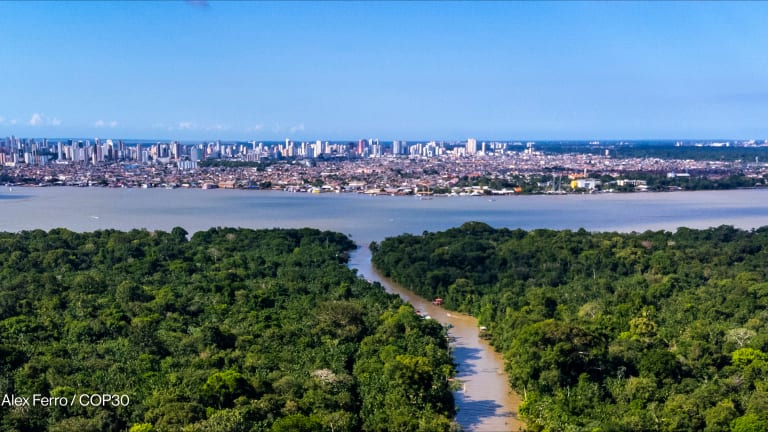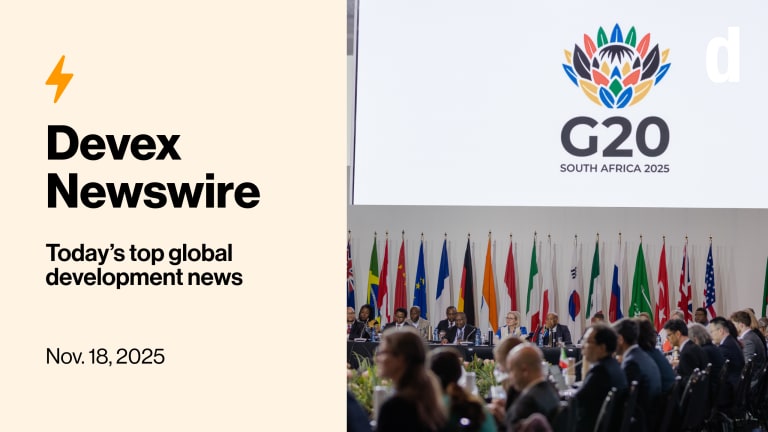Presented by Sexual Violence Research Initiative (SVRI)

A power struggle between the global north and global south plays out in real-time — and exposes the bitterness that can fester when an organization tries to figure out who really holds the reins.
Also in today’s edition: We travel to the troubled waters of the Mekong River, where locals are taking the lead in preserving this tributary of life and livelihoods.
+ Join us tomorrow, Aug. 16, for a Devex Career workshop on how to write a cover letter that matters. Save your spot now.
The unraveling of White Ribbon
It seemed like the White Ribbon Alliance had tied a neat red bow around its work advocating for maternal health care. The U.S. secretariat, based in Washington, D.C., was shuttering its doors to make way for new leaders, voices, and ideas from around the world. It was a shining example of localization in action — until it all unraveled, revealing a deep schism with members in the global south.
White Ribbon is an alliance of alliances, with each entity operating both autonomously and in tandem, my colleague Elissa Miolene writes. Nine of those national alliances rebelled against the U.S.-based secretariat’s plans to sunset its work, saying the closure had nothing to do with shifting power — in part because the alliances already had plenty of it.
This is a preview of Newswire
Sign up to this newsletter for an inside look at the biggest stories in global development, in your inbox daily.
“We are still alive. We have not died. And we are still moving, still working,” says Angela Nguku, who helped form the Global White Ribbon Alliance Leadership Team, or GAL, to carry the movement forward.
Rather than a benevolent act, GAL claims the U.S. entity was closing because it faced financial hardship and that the secretariat was refusing to give local alliances exclusive rights to resources they had created.
The secretariat released those resources, including data, documents, and tools, to the public under a “global goods” platform called World We Want, which allows anyone, anywhere to access them online.
“Everyone still has the same opportunity to leverage, share, copy, and remix the valuable World We Want toolbox to advance their ambitions and most importantly those of women and girls,” the secretariat said in a statement.
But in this tug of war, ambitions seem to have clashed. Today, there are two separate entities representing White Ribbon — one created by the secretariat, and another run by GAL — with no clear indication of who will carry the mantle forward.
Exclusive: A global north-south battle over a maternal health alliance (Pro)
Related: White Ribbon Alliance sunsets US operation to shift power locally (Pro)
+ Not yet a Devex Pro member? Start your 15-day free trial today to access all our expert analyses, insider insights, career resources, exclusive events, and more. Check out all the exclusive content available to you.
The mighty Mekong
Locals who live around the Mekong River are protecting their turf but in a different way. They’re fighting climate change and dam construction to restore their river and safeguard their incomes.
The Mekong, which snakes 2,700 miles through six Asian countries, is the world’s largest inland fishery. It’s teeming with close to 1,200 different fish species, and over 40 million people rely on the river for their livelihoods.
Devex contributing reporter Rebecca Root traveled to Thailand to create a visual story of the river and the communities around it, speaking to people such as Sorn Champadok, a fisherwoman who used to spend every day in her wooden fishing boat and earn 100,000 Thai baht (about $2,700) a month. Now, with the Mekong’s fish stocks depleted, she only fishes once every 10 days out of tradition but loses money.
“In the future, not only my village, but all the people by the Mekong River will be victims,” she says.
But that doesn’t mean she’s just lying down and accepting her plight. Champadok is part of a local collective that has tried, albeit unsuccessfully, to file lawsuits to stop further dam construction. Aware there’s likely little they can do to stop what happens higher up the river in places such as China, they’re also trying to find alternative ways to generate income. That includes establishing fish conservation zones and even organizing a Pride event to boost tourism.
International organizations are also trying to help. For example, DAI and USAID have worked with rural communities in Laos, Thailand, and Vietnam to research the potential loss of money as a result of climate change.
Suriyan Vichitlekarn, executive director of the Mekong Institute, says such expertise, resources, and collaboration are needed to ensure the survival of the Mekong. “We cannot stop the problem that is climate change,” he says, “but we can be more resilient, we can be more prepared, we can respond, and we can contribute less to our gas emissions.”
Explore the visual story: How local groups are fighting to revive world's largest inland fishery
Local savings
One of the prime arguments in favor of localization is not only that it’s generally more effective, but also specifically that it’s more cost-effective.
In Ukraine, delivering aid through local organizations instead of much larger organizations such as the United Nations could’ve saved the war-torn country hundreds of millions of precious dollars, according to a new study by The Share Trust.
The projects currently in local hands are 15.5% more cost-efficient than those administered by international bodies — because of lower overhead and salary costs — the analysis found.
My colleague Rob Merrick writes that with $3.5 billion in aid reaching Ukraine in 2023, and the U.N. calling for $3.1 billion for 2024, some $256 million could be freed up over two years, the study argues — creating “a clear moral argument for shifting greater funding and decision-making power to local actors.”
Read: Ukraine recovery could gain $256M from localizing aid, study finds
+ Localization is all the rage in development, but who’s actually doing it on the ground? We’re compiling a list of local organizations to watch and we’d like your help! Send a note to hayley.mundeva@devex.com if you’d like your organization to be considered or if you know of one that deserves to make it onto the list. Stay tuned next month for the results!
Homegrown giving
Africa is often seen as a destination for philanthropic dollars, not as a source of them. But times are changing.
The rise of Africa’s megarich and the slowdown in the global economy are paving the way for the growth of locally led African philanthropy, Dr. Otto Chabikuli, FHI 360’s vice president of the eastern and southern Africa region, and Constance Shumba, who has worked for global health agencies in Africa and Asia over the last 19 years, argue in an opinion piece for Devex.
“From startups to manufacturing, Africa is seeing a surge in private investment — and a corresponding expansion of personal wealth,” they write, noting that the latest Africa Wealth Report estimates total private wealth of $2.4 trillion is held on the continent and that 138,000 high net-worth individuals live in Africa.
“As complex crises worldwide compete for scarcer resources, philanthropic giving by Africa’s clutch of newly minted millionaires can make a difference,” they add. “No matter how large or small the gift, local assistance is essential, not least because locally led development is more equitable, impactful, and sustainable.”
Opinion: African philanthropy promises dynamic responses to local needs
On the front lines
At $2.5 million, the Conrad N. Hilton Humanitarian Prize is the world’s largest annual humanitarian award — and this year’s prize is going to a nonprofit that supports Indigenous people in defending their land, preserving biodiversity in the Amazon, and protecting the environment.
Amazon Frontlines is the first organization of Indigenous and Western human rights and climate activists to receive the prize, which is given to a nonprofit that has made extraordinary contributions toward alleviating human suffering.
Since its founding in 2011, Amazon Frontlines has focused on protecting the rainforest homelands of dozens of Indigenous nations from further mining, drilling, and deforestation using grassroots organizing, advocacy, legal defense, and cutting-edge technology such as GPS mapping.
“For more than a decade, Amazon Frontlines has worked hand-in-hand with Indigenous leaders to develop proven, scalable, and sustainable models of locally led conservation — approaches that are vital to protecting the Amazon and therefore our entire planet," Peter Laugharn, president and CEO of the Conrad N. Hilton Foundation, said.
In other news
The Taliban’s three-year rule marks a grim milestone as life in Afghanistan remains dire, with at least 1.4 million girls denied access to secondary education since they took power. [DW and AP]
Climate change significantly contributed to last month's torrential rains in India, which caused catastrophic landslides and claimed at least 200 lives, according to a network of scientists. [France 24]
Meta has shut down a misinformation tracking tool widely used by researchers, watchdogs, and journalists to monitor the spread of misinformation on the company's platforms. [AP]
Sign up to Newswire for an inside look at the biggest stories in global development.








